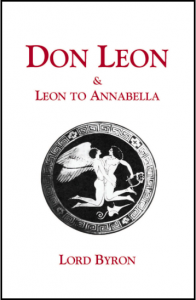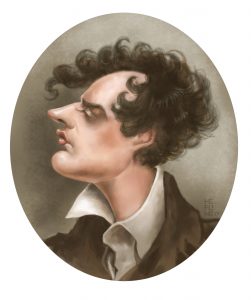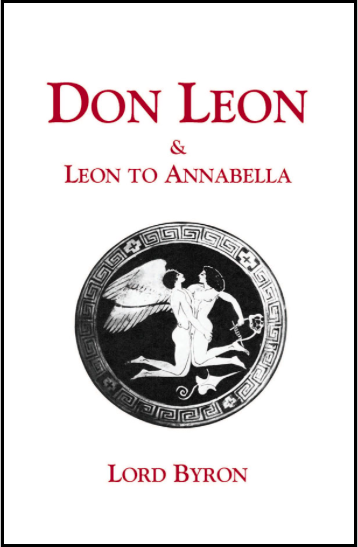 Don Leon and Leon to Annabella: Lord Byron
Don Leon and Leon to Annabella: Lord Byron
Edited by John Lauritsen
Pagan Press. 185 pages, $14.99
REVIEWING John Lauritsen’s Don Leon is in essence reviewing a review, as the book is entirely concerned with the meaning and provenance of another author’s work. Lauritsen thus provides two benefits in one package. We get the full text of these two peculiar and interesting poems and also the assembled end result of an exceptionally thorough detective story involving the work of several serious researchers over a period of a hundred years. “End result” may be the wrong term for an investigation that has only a misty closure, but we get what is currently known, laid out in a way that allows any reader, even one not steeped in Byronic lore, both to enjoy the poem and appreciate the work of Inspector Lauritsen and his fellow sleuths.
Byron had a complex and somewhat troubled sexual life that would be recognized as a bisexual variant today. He seems never to have met a woman he didn’t instinctively seduce—not that they fled from the handsome and charming writer. To the contrary, one of his more significant female companions pursued him ever more strangely for years, sometimes dressed as a boy. As James Merrill put it upon seeing an opera in which the understudy soprano stepped in for the final act, she changed her hair, but it didn’t save her marriage. Byron was ditched by his one actual wife, apparently on fidelity grounds, after a very short time together. I can’t help but wonder what credibility he thought he had by the time he wrote in Leon to Annabella of “all those I scorned” in order to remain loyal to Annabella. He scorned very few.
But the words “he wrote” in that last sentence need to be explored. One of the main issues in this book is whether in fact Byron wrote any of this work at all. Lauritsen makes a plausible case that Byron probably did write the Annabella poem, though the story of its discovery in a peasant’s hut once used by Byron reads like something from the annals of P.D.Q. Bach. Annabella has a masterful rippling cadence to it and is more readable and enjoyable as a poem than is Don Leon. It feels more personal than Don Leon and has some pointed, powerful, and delicately snarky language that we might easily use today:
Between the sheets salacious lawyers pry.
Yet nature varies not:—desires we feel,
As Romans felt; but woe! if we reveal,
For what were errors then, our happy times
With sainted zeal have registered as crimes.
By comparison to Annabella, Don Leon is really a sort of political brief dressed as a poem. A rather bald statement of the need for social tolerance of homosexuality, Don Leon is far ahead of its time, the first such statement known to be issued in English, though Jeremy Bentham wrote something that was not published. A much more direct, forceful, and in some ways cheerful ride than André Gide’s austere, academic Corydon (1911) almost a century later, Don  Leon feels more like Aaron Fricke saying in 1980 that he is damn well going to take his boyfriend to the prom, and society needs to get over it. Not only is the tone unusual for its subject and time period, but the brute clarity of the message is akin to the opening of Stravinsky’s Rite of Spring: a writhing platter of radical new ideas simply heaved into the unprepared face of the prevailing social order.
Leon feels more like Aaron Fricke saying in 1980 that he is damn well going to take his boyfriend to the prom, and society needs to get over it. Not only is the tone unusual for its subject and time period, but the brute clarity of the message is akin to the opening of Stravinsky’s Rite of Spring: a writhing platter of radical new ideas simply heaved into the unprepared face of the prevailing social order.
In addition to his more obvious and traditional hetero sex games, Byron took seriously at least one part of his early Calvinist upbringing: “God made man—let us love him,” though in Byron’s case God made boy. He had a taste for Gide-lings, though he quite sensibly approached writing of his uranic desires for teenage lads in a manner both oblique and coded, like the far more astringent and reserved A. E. Housman a century later [see essay on page 15]. Whether he personally wrote these words in Don Leon can be argued, but their meaning, and the meaning of similar passages, cannot:
Full well I knew, though decency forbad
The same caresses to a rustic lad;
Love, love it was, that made my eyes delight
To have his person ever in my sight.
Don Leon was published in one form in 1866 but written much earlier, probably in the 1830s or even 1820s, and most likely by several authors. Even if you know nothing of Byron the bisexual and don’t care to, this work is an important piece of gay history. As a poem it is somewhat labored and quite variable, which lends weight to Lauritsen’s view that it is in all likelihood the work of several quills, albeit in skillful hands, perhaps followers poetical, sexual, and temporal of Lord Byron: a dead poet’s society, if you will.
So who wrote Don Leon? Lauritsen also published this year The Shelley-Byron Men: Lost Angels of a Ruined Paradise, which helps flesh out the nature of the group of young men clustered around the two poets in Italy. Speculation on how they might have collectively added to Leon appears in the Don Leon collection; the setting and relationships that serve as a principal basis for that theory are set forth in Lost Angels.
The response to Don Leon’s request for a new way of thinking about sexual variety was social shock. Early printings of this work were destroyed in one way or another, and the text became a rare and nearly mythical presence in gay history. As late as 1934, the London police treated a printing of this work as bonfire material. Whether these poems were by Byron, the school of Byron, friends and followers of Byron, or just courageous gay people determined to right a wrong, the poems themselves are a remarkable milestone of gay history, and we can all be grateful for their appearance in this exceptionally thorough source.
Alan Contreras is a writer and higher education consultant who lives in Eugene, Oregon.





